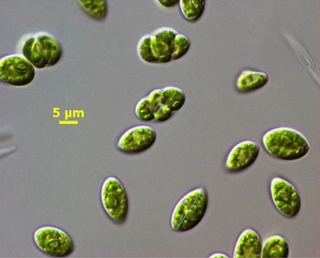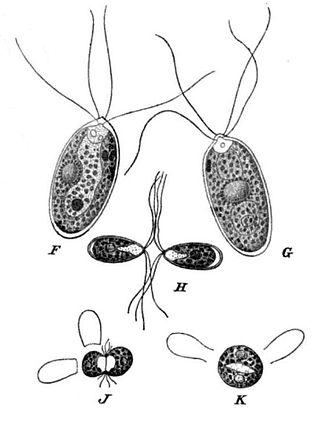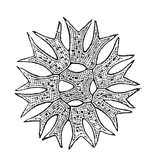
Sphaeropleales is an order of green algae that used to be called Chlorococcales. The order includes some of the most common freshwater planktonic algae such as Scenedesmus and Pediastrum. The Sphaeropleales includes vegetatively non-motile unicellular, colonial, or filamentous taxa. They have biflagellate zoospores with flagella that are directly opposed in direction : Sphaeroplea, Atractomorpha, Neochloris, Hydrodictyon, and Pediastrum. All of these taxa have basal body core connections. Motile cells generally lack cell walls or have only a very fine layer surrounding the cell membrane. Other common characteristics include a robust vegetative cell wall, cup-shaped chloroplasts with large pyrenoids, and relatively large nuclei.

Hydrodictyaceae is a family of green algae in the order Sphaeropleales. They are found in freshwater habitats worldwide.

Characiochloridaceae is a family of green algae in the order Chlamydomonadales.
The Characiosiphonaceae are a family of algae in the order Chlamydomonadales. Two genera are included in this family, Characiosiphon and Lobocharacium, each containing a single species. The genus Characiochloris may eventually be placed in this family pending future revisions, as it is phylogenetically closely related to the twose genera.

Neochloridaceae is a family of green algae in the order Sphaeropleales.

Selenastraceae is a family of green algae in the order Sphaeropleales. Members of this family are common components of the phytoplankton in freshwater habitats worldwide. A few species have been found in brackish and marine habitats, such as in the Baltic Sea.

Eudorina is a paraphyletic genus in the volvocine green algae clade. Eudorina colonies consist of 16, 32 or 64 individual cells grouped together. Each individual cell contains flagella which allow the colony to move as a whole when the individual cells beat their flagella together. Description by GM Smith :

Ankistrodesmus is a genus of green algae in the family Selenastraceae. It is one of the most common types of phytoplankton in freshwater habitats around the world. The name Ankistrodesmus comes from the Greek roots ankistron, meaning "cross", and desmos, meaning "bond".

Carteria is a genus of green algae in the family Chlamydomonadaceae. Carteria are similar in morphology to the common genus Chlamydomonas and differ by having four, rather than two, flagella at the vegetative stage.

Dictyosphaerium is a genus of green algae, in the family Chlorellaceae. It occurs in freshwater habitats around the world and is planktonic. The name comes from the Greek roots diktyon, meaning "net", and sphaira, meaning "ball", referring to its morphology.
Lobocharacium is a genus of green algae in the family Characiosiphonaceae. It contains the single species Lobocharacium coloradoense. It has been isolated from a pond in Colorado, United States.

Monactinus is a genus of green algae in the family Hydrodictyaceae. It is very common in freshwater regions throughout the world.

Pediastrum is a genus of green algae, in the family Hydrodictyaceae. It is a photoautotrophic, nonmotile coenobial green alga that inhabits freshwater environments. The name Pediastrum comes from the Greek root words pedion, meaning "plane", and astron, meaning "star", referring to its overall shape.
Pseudomuriella is a genus of green algae, specifically of the class Chlorophyceae. It is the sole genus of the family Pseudomuriellaceae. It is a terrestrial alga that inhabits soils.

Pseudopediastrum is a genus of green algae in the family Hydrodictyaceae. It is very common in freshwater regions throughout the world.

Selenastrum is a genus of green algae in the family Selenastraceae. It is common in freshwater habitats around the world. Most species prefer temperate or warm-temperate waters.

Stauridium is a genus of green algae in the family Hydrodictyaceae. It is very common in freshwater regions throughout the world.

Treubaria is a genus of microscopic green algae, the sole genus in the family Treubariaceae. Treubaria is found in freshwater habitats and has a cosmopolitan distribution.

Pediastrum duplex is a species of fresh water green algae in the genus Pediastrum. It is the type species of the genus Pediastrum.
Prescottiella is a genus of green algae in the family Desmidiaceae, containing the single species Prescottiella sudanensis. Originally classified as Micrasterias sudanensis in 1958, it was moved into its own genus by Carlos E. M. Bicudo in 1976, due to its asymmetric character. It is named after Gerald Webber Prescott, an American phycologist.














